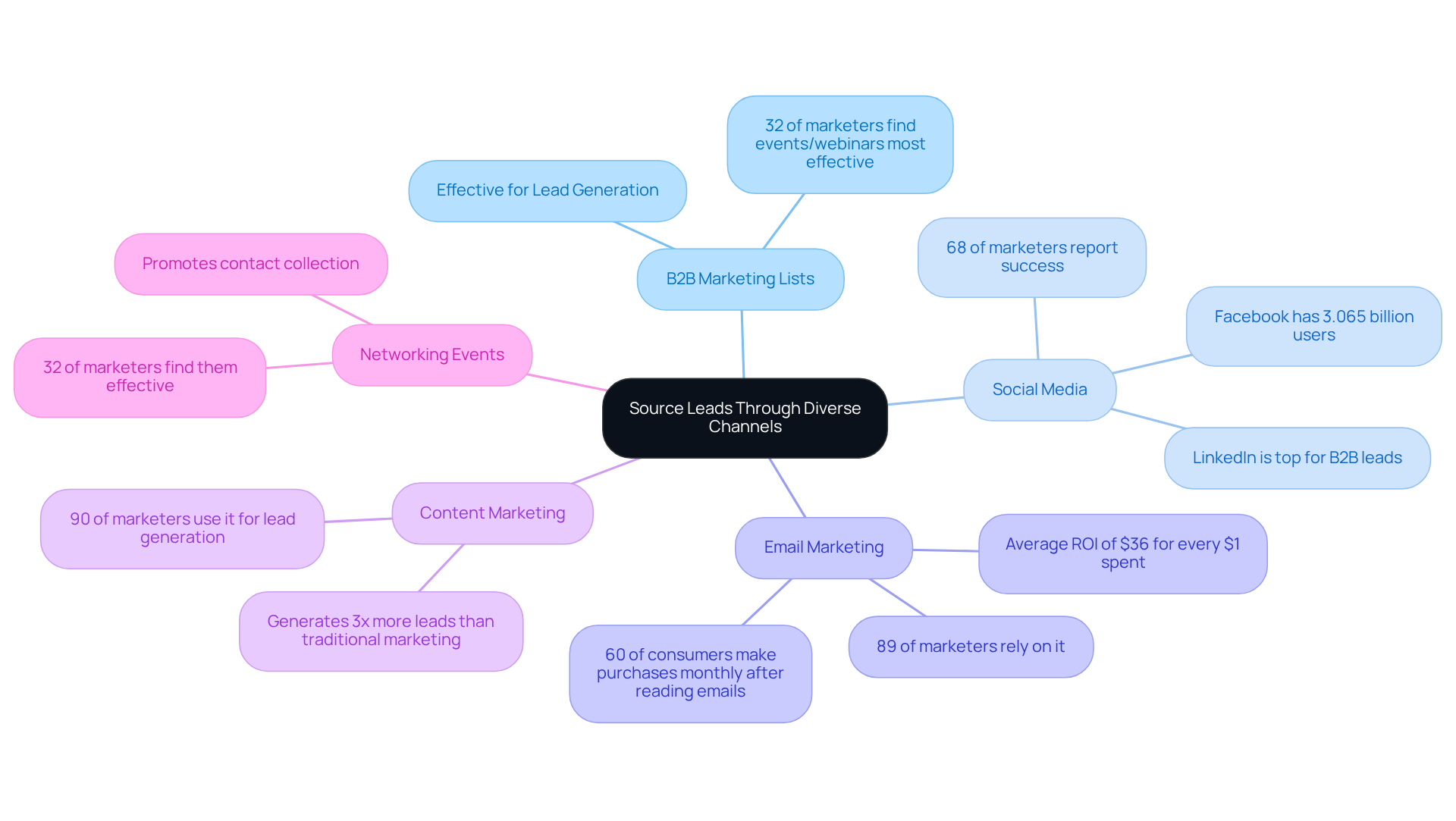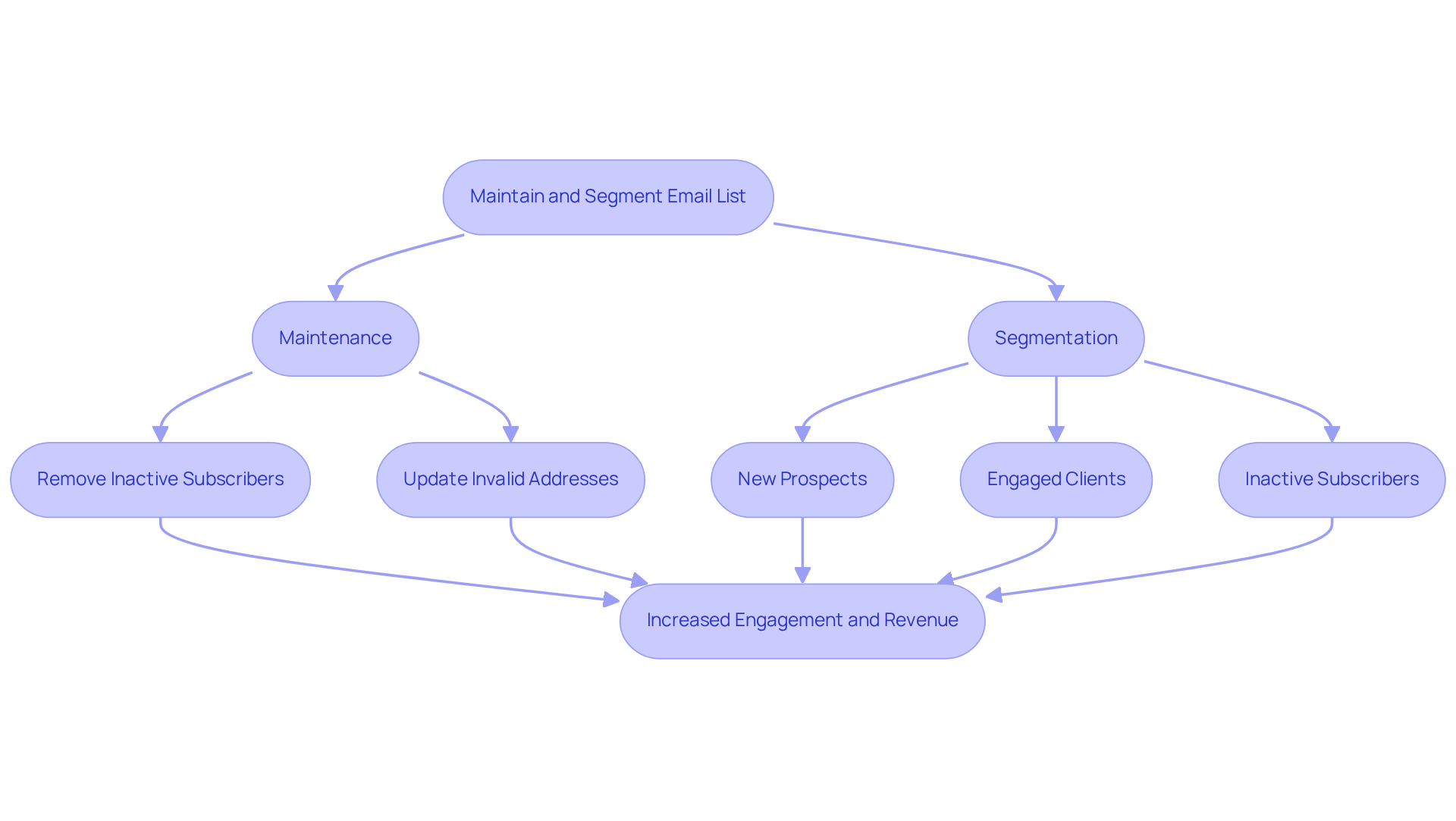Overview
In this article, we explore four compassionate strategies for building effective B2B marketing lists that truly resonate with your needs.
- First, we emphasize the importance of defining an Ideal Customer Profile (ICP) to ensure your efforts are targeted.
- Next, we discuss sourcing leads through diverse channels, recognizing that variety can enhance your outreach.
- Maintaining and segmenting email lists is crucial, as it allows for tailored communication that speaks directly to your audience.
- Finally, we highlight the power of leveraging automation for outreach, making your processes smoother and more efficient.
Each of these strategies is supported by insightful data and relatable examples that demonstrate how they can enhance lead generation, improve engagement, and ultimately drive sales productivity.
It’s vital to understand that targeted and personalized marketing efforts are not just strategies—they are ways to connect with your audience on a deeper level. Together, we can navigate these challenges and achieve success in your marketing journey.
Introduction
Building effective B2B marketing lists is not merely a task; it’s a strategic necessity in today’s competitive landscape. We understand the challenges small businesses face, and by honing in on the characteristics of ideal clients and leveraging diverse channels for lead generation, you can significantly enhance your outreach efforts. However, the question remains: how can you ensure that your marketing lists are not only comprehensive but also targeted and engaging?
This article explores four essential strategies that empower you to cultivate robust B2B marketing lists, ultimately driving better engagement and higher conversion rates. Together, we can navigate this journey towards success.
Define Your Ideal Customer Profile (ICP)
Creating an effective Ideal Client Profile (ICP) begins with a compassionate examination of your current clientele. Have you noticed common traits among your top clients, such as their industry, company size, revenue, and pain points? By utilizing surveys or interviews, you can gather qualitative data that, when combined with quantitative metrics from your CRM, paints a clearer picture. This profile will serve as a nurturing blueprint for your marketing strategies, particularly in creating B2B marketing lists that guide your outreach efforts to attract similar businesses.
For instance, if your top clients are small tech startups within a specific revenue range, consider customizing your messaging and channels to connect with that demographic directly. It’s important to consistently review and enhance your ICP based on market changes and client feedback, ensuring it remains relevant and effective.
Aligning your marketing and sales teams around a well-defined ICP, along with utilizing B2B marketing lists, can lead to remarkable outcomes such as:
- A 36% increase in client retention rates
- A 38% boost in sales win rates
As Tracy Eiler, CMO at InsideView, emphasizes, developing an ICP is essential for fostering long-term client relationships. Moreover, adjusting your ideal customer profile has been shown to increase deal size by an impressive 83% within just one year.
However, it’s vital to be mindful of common pitfalls, such as defining your ICP too broadly or too narrowly. By doing so, you can maximize its effectiveness and truly understand the needs of your clients. Together, we can and achieve success in your business journey.

Source Leads Through Diverse Channels
To effectively identify prospects, it’s essential to explore various channels, including:
- B2B marketing lists
- Social media
- Email marketing
- Content marketing
- Networking events
For instance, leveraging LinkedIn allows businesses to connect with industry professionals and share valuable content, positioning themselves as thought leaders. Did you know that 82% of B2B marketers view LinkedIn as a primary avenue for customer acquisition? Participating in industry conferences can also promote networking and contact collection; in fact, 32% of marketers stated that events and webinars were the most effective channels for creating B2B marketing lists.
Additionally, utilizing paid advertising on platforms like Google Ads or Facebook enables targeted outreach to specific demographics based on your ideal customer profile (ICP). Each channel offers distinct benefits; social media excels in brand recognition, while electronic communication is particularly powerful for nurturing prospects. Significantly, for every dollar invested in electronic communication, companies can anticipate earning an average of $42. By diversifying your source options, you can build a more robust pipeline and reduce risks associated with relying on a single channel.
In reality, 68% of marketers indicate that social media strategies have greatly supported their prospect generation efforts, and 89% of marketers view email campaigns as their most effective approach. This multi-channel approach not only enhances lead quality but also fosters stronger engagement with potential clients through B2B marketing lists. As one marketing professional wisely noted, "Email achieves some of the highest conversion rates among digital channels." Together, we can in your prospecting efforts.

Maintain and Segment Your Email List for Engagement
To ensure high deliverability rates, we understand how crucial it is to regularly clean your b2b marketing lists. This includes:
- Removing inactive subscribers
- Updating invalid addresses
Additionally, segmenting your b2b marketing lists based on demographics, purchase history, and engagement levels can make a significant difference. For example, creating unique segments for:
- New prospects
- Engaged clients
- Inactive subscribers
allows you to send personalized messages that truly connect with each group. This approach greatly enhances the probability of engagement through b2b marketing lists.
Automation tools can also be a game-changer, facilitating the delivery of personalized content and offers tailored to recipient behavior and preferences. With Wayy.ai, you can gain into what works best for your audience through daily updates. These updates provide essential metrics on:
- How many prospects were contacted
- Who expressed interest
- How your conversion rates are improving
By adopting this data-driven strategy, you can send targeted promotions related to specific products to segments that show interest using b2b marketing lists. This not only enhances engagement but also helps cultivate a stronger relationship with your audience. It's inspiring to note that marketers utilizing segmentation report a remarkable 760% increase in revenue, highlighting the effectiveness of these practices. Together, we can navigate these challenges and achieve success in your marketing efforts.

Leverage Automation for Efficient Outreach
Implementing automation tools can significantly enhance your outreach efforts, and we understand how crucial this is for your business. By using automation tools for messaging, you can effectively plan and dispatch customized communications on a large scale, ensuring prompt follow-ups with your prospects. Imagine setting up automated processes that activate messages based on specific actions, like downloading a resource or registering for a webinar. Integrating your CRM system with your messaging marketing platform is essential for monitoring interactions and managing prospects effectively. This integration allows you to segment your audience and tailor your messaging based on their behavior. By utilizing automation, you can maintain consistent communication with your prospects, nurture relationships, and ultimately drive conversions without overwhelming your team.
The advantages of automated messaging for lead nurturing are substantial and can truly make a difference. Automated messages have been shown to achieve a 70.5% greater open rate and a 152% increased click-through rate compared to generic newsletters. Additionally, automated emails account for 37% of all email-generated sales, despite representing only 2% of email volume. Companies that embrace automation in their promotions report a 14.5% rise in sales productivity and a 12.2% decrease in promotional expenses. With 92% of users seeking to through automation, it’s clear that these tools are vital for contemporary marketing strategies.
Current trends reveal that:
- 81% of marketers prioritize customer retention with automation.
- 66% focus on nurturing prospects.
- 92% of users indicated that their primary goal for using automation was to enhance their qualified lead pipeline.
This shift highlights the importance of personalized communication in driving engagement and conversions. By adopting these strategies, small businesses like yours can optimize outreach efforts and foster meaningful connections with potential clients. Together, we can achieve success in enhancing your marketing approach.

Conclusion
Defining and refining your Ideal Customer Profile (ICP) is essential for businesses like yours that are striving to enhance B2B marketing efforts. By truly understanding the characteristics of your top clients, you can tailor your outreach and messaging to attract similar prospects. This thoughtful approach not only improves client retention and sales win rates but also nurtures stronger, long-term relationships with your customers.
To build effective B2B marketing lists, consider sourcing leads through diverse channels, maintaining and segmenting your email lists, and leveraging automation for efficient outreach. Each of these strategies contributes to a more robust marketing plan, allowing you to engage potential clients more effectively. For instance, integrating automation tools streamlines communication and nurtures relationships, ultimately driving conversions and increasing your revenue.
In today's rapidly evolving marketing landscape, embracing these best practices is vital for your success. By focusing on defining an ICP, diversifying lead sources, and maintaining engagement through segmented lists and automation, you can position your business for growth and sustainability. Remember, the importance of these strategies cannot be overstated; they are foundational elements that can significantly enhance the effectiveness of your B2B marketing initiatives. Together, we can achieve success and overcome the challenges you face.
Frequently Asked Questions
What is an Ideal Customer Profile (ICP)?
An Ideal Customer Profile (ICP) is a detailed description of the characteristics of your ideal clients, including traits such as industry, company size, revenue, and pain points. It helps businesses tailor their marketing strategies to attract similar clients.
How can I create an effective ICP?
To create an effective ICP, examine your current clientele for common traits, utilize surveys or interviews to gather qualitative data, and combine it with quantitative metrics from your CRM. This information will help you develop a clearer picture of your ideal clients.
Why is it important to review and enhance my ICP?
Regularly reviewing and enhancing your ICP is important to ensure it remains relevant and effective in response to market changes and client feedback. This helps in maintaining alignment with your target audience.
What benefits can aligning marketing and sales teams around a well-defined ICP bring?
Aligning marketing and sales teams around a well-defined ICP can lead to significant benefits, including a 36% increase in client retention rates and a 38% boost in sales win rates.
How can adjusting my ICP impact deal size?
Adjusting your ICP can lead to an increase in deal size by as much as 83% within just one year, fostering long-term client relationships.
What common pitfalls should I avoid when defining my ICP?
Common pitfalls include defining your ICP too broadly or too narrowly. It's important to strike a balance to maximize the effectiveness of your ICP and truly understand your clients' needs.




